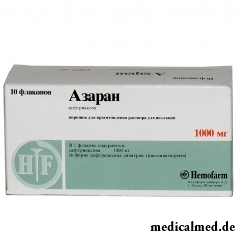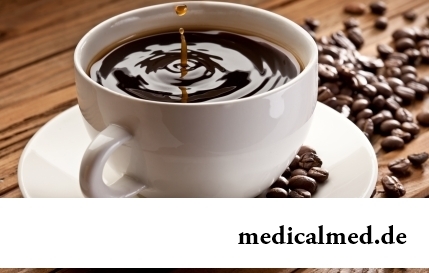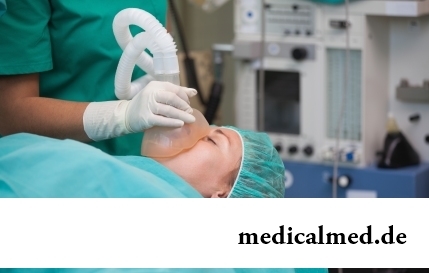





Azawounds
Application instruction:
 Azawounds – a wide range of bactericidal action the antibiotic of group of cephalosporins (the III generation) intended for parenteral administration.
Azawounds – a wide range of bactericidal action the antibiotic of group of cephalosporins (the III generation) intended for parenteral administration.
Form of release and structure
Dosage form of Azaran – powder for preparation of solution for intravenous and intramuscular administration: powdery weight from white with a yellowish shade till white color (on 1,0 g in the bottles of colourless glass corked by the combined cover from plastic, rubber and metal with function of control of the first opening; 1, 10 or 50 bottles in a cardboard pack).
1 bottle contains active ingredient: цефтриаксон sodium (in terms of цефтриаксон) – 1,0 g.
Indications to use
Azawounds apply to therapy of the following infectious and inflammatory diseases caused by the microorganisms sensitive to a tseftriakson:
- Respiratory infections (upper and lower parts), including pneumonia, abscess of lungs, a pleura empyema;
- Infections of bones and joints;
- Infections of skin and soft tissues;
- Infections of urinary tract, including pyelonephritis;
- Infections of bodies of a small pelvis;
- Inflammations of the digestive tract (DT) and bilious channels, including a cholangitis and an empyema of a gall bladder;
- Bacterial meningitis;
- Bacterial endocarditis;
- Peritonitis;
- Sepsis;
- Lyme's disease;
- Salmonellosis;
- Acute uncomplicated gonorrhea;
- Shigellosis.
Also drug is used in postoperative practice for prevention and treatment of infectious complications.
Contraindications
Absolute:
- Hypersensitivity to other penicillin, cephalosporins, and karbapenema;
- Hypersensitivity to Azaran's components.
Relative (drug is used with care, in connection with the increased risk of side effects):
- Abnormal liver functions and/or kidneys;
- Hyperbilirubinemia at newborns, especially premature;
- Nonspecific Ulcer Colitis (NUC);
- The enteritis or colitis connected using antibiotics.
As цефтриаксон gets through a placenta, at pregnancy therapy by Azaran is possible only according to indications, in case of exceeding of estimated advantage for mother over potential risk for a fruit.
In need of use of drug in the period of a lactation it is required to resolve an issue of breastfeeding interruption since цефтриаксон it is allocated with maternal milk.
Route of administration and dosage
The solution received from powder is entered intramusculary (in oil), either intravenously (in/in) struyno or kapelno, 1 time a day if there are no other appointments.
The recommended average daily dose:
- Newborns and children up to 14 days – 20-50 mg/kg, as much as possible to 50 mg/kg;
- Children from 15 days to 12 years – 20-80 mg/kg;
- Children of 12 years and adult – 1000-2000 mg, as much as possible to 4000 mg.
To children 12 years with the body weight of ≥50 kg are younger apply adult doses.
Solution in a daily dose of 50 mg/kg and is more entered infusionally for half an hour.
Therapy course duration usually no more than 10 days. After removal of symptoms of a disease and normalization of temperature it is necessary to continue administration of drug 2-3 more days.
The recommended dosing in special cases:
- Prevention of infections in the postoperative period: 1000-2000 mg in 30-90 min. prior to operation once (the dose depends on degree of infectious risk); at operations on thick and a rectum it is recommended to administer in addition the drug from group 5 of nitroimidazoles;
- Bacterial meningitis at children of chest and younger age: 100 mg/kg of 1 times a day, as much as possible to 4000 mg; duration of a course depends on the activator and can be from 4 days (the meningitis caused by Neisseria meningitidis) to 10-14 days (the meningitis caused by sensitive strains of Enterobacteriaceae);
- Acute uncomplicated gonorrhea: 250 mg in oil once;
- Lyme's disease: 50 mg/kg of 1 times a day (adults and children), as much as possible to 2000 mg; course duration – 14 days.
Dose adjustment is required at heavy degree of a renal failure with the clearance of creatinine (CC) of ≤10 ml/min., the daily dose of a tseftriakson at the same time should not exceed 2000 mg.
In dose adjustment of a tseftriakson patients have no need: with a moderate renal failure at normal function of a liver; with abnormal liver functions at normally functioning kidneys.
At a combination of a renal and liver failure regular control of concentration of a tseftriakson in plasma, and according to indications correction of its dose is carried out.
After carrying out dialysis patients do not need additional administration of drug as holding a procedure does not promote removal of a tseftriakson. But the hemodialysis can change the speed of its removal therefore control of concentration of drug in a blood plasma is important for possible dose adjustment.
Solution for introduction in oil can be prepared for one of two recommended ways:
- To dissolve 1000 mg of a tseftriakson in 3,6 ml of water for injections, 1 ml of the received solution contains ~ 250 mg of a tseftriakson if it is necessary, it is possible to apply less strong solution;
- To dissolve 1000 mg of a tseftriakson in 3,5 ml 1% of solution of lidocaine of chloride for introduction no more than 1000 mg in one muscle are deep in quite large muscles (buttock or a muscle of a hip), but; solution of lidocaine of chloride cannot be entered in/in.
Solution for in/in introductions prepares as follows:
- Injections: To dissolve 1000 mg of drug in 9,6 ml of sterile water for injections, 1 ml of the received solution contains ~ 100 mg of a tseftriakson; it is necessary to enter solution in/in slowly for 2-4 min.;
- Infusions: 2000 mg of powder dissolve in 40 ml of one of the following solutions which are not containing calcium – 0,9% chloride sodium solution; 0,45% chloride sodium solution from 2,5% dextrose solution; 6% dextran solution in 5% dextrose solution; 5% or 10% dextrose solution; 6-10% solution of hydroxyethylated starch; duration in/in infusion has to make not less than half an hour.
Freshly cooked solutions from powder Azaran are stable at the room temperature during 6 h and no more than 24 h at a temperature of 2-8 °C (storage in the refrigerator).
Side effects
- Central Nervous System (CNS): dizziness, headache;
- Urinary system: renal failure (increase in content in urea blood, azotemia, giperkreatininemiya, cylindruria, hamaturia, glucosuria, oliguria, anury);
- Alimentary system: an abdominal pain, taste disturbance, nausea, vomiting, dysbacteriosis, a meteorism, a glossitis, stomatitis, a lock or diarrhea, a pseudo-cholelithiasis ("sludge" - a syndrome), a pseudomembranous coloenteritis, increase in activity of hepatic transaminases and an alkaline phosphatase, cholestatic jaundice, a hyperbilirubinemia;
- System of a hemopoiesis: leukopenia, anemia, leukocytosis, neutropenia, lymphopenia, granulocytopenia, thrombocytosis, thrombocytopenia, hemolitic anemia, basophilia;
- Coagulant system of blood: decrease in plasma blood-coagulation factors (namely, II, VII, IX, X), hypocoagulation, increase in a prothrombin time, nasal bleeding;
- Hypersensitivity reactions: acute anaphylaxis, rash, itch, small tortoiseshell, fever, fever; seldom – hypostases, an eosinophilia, a bronchospasm, an exudative mnogoformny erythema (including a malignant exudative erythema or Stephens-Johnson's syndrome), a serum disease;
- Local reactions: in/in introduction – morbidity on the vein course, phlebitis; introduction in oil – pains in an injection site;
- Others: superinfections, including candidiasis.
Special instructions
Azawounds it is applied only in the conditions of a hospital!
In case of long therapy it is necessary to carry out regular control of a picture of peripheral blood, and also indicators of a functional condition of kidneys and a liver.
Occasionally, at ultrasound examination (ultrasonography) of a gall bladder blackouts which disappear independently after drug withdrawal (even are visible if this phenomenon is followed by pain in right hypochondrium, it is recommended to carry out a symptomatic treatment and to continue use of an antibiotic).
It is impossible to use ethanol at therapy by Azaran as there is a probability of development of the following disulfiramopodobny reactions: nausea, vomiting, rush of blood to the person, spastic pains in epigastric area, a headache, a lowering of arterial pressure (ABP), an asthma, tachycardia.
The elderly and weakened patients need in a complex with tseftriaksony purpose of vitamin K.
Before Azaran's use (as well as other cephalosporins) detailed collecting the anamnesis, but, despite its results is carried out, it is impossible to exclude a possibility of development of an acute anaphylaxis. The state demands immediate treatment: at first in/in introductions of Epinephrinum, and then glucocorticosteroids.
According to the researches in vitro it is revealed that цефтриаксон (as well as other cephalosporins) the blood serum bilirubin connected with albumine is capable to force out. Thereof at newborns with a hyperbilirubinemia, especially premature, it is required to apply цефтриаксон with a bigger care.
Medicinal interaction
- Aminoglycosides – work synergistically with tseftriaksony for many gram-negative bacteria (including Pseudomonas aeruginosa), they need to be entered in the recommended doses separately;
- The drugs reducing aggregation of thrombocytes (non-steroidal anti-inflammatory drugs, Sulfinpyrazonum, salicylates) – цефтриаксон suppresses an indestinal flora, interfering with vitamin K synthesis, thereby increasing risk of development of bleedings;
- Anticoagulants – their anticoagulating action amplifies;
- "Loopback" diuretics and other nefrotoksichny drugs – the risk of their nephrotoxic influence increases;
- Ethanol – Azaran is incompatible with the means containing alcohol;
- The solutions containing other antibiotics (including aminoglycosides and Vancomycinum), and the solutions containing флуконазол – pharmaceutical are incompatible with Azaran;
- Solutions, calciferous (including Ringer's solution) – it is impossible to mix with tseftriaksony.
Terms and storage conditions
To store in the dark place, at a temperature of 15-25 °C. To protect from children.
Period of validity – 3 years.
The educated person is less subject to brain diseases. Intellectual activity promotes formation of the additional fabric compensating sick.

What will only not be thought up by persons interested to have a beautiful figure. Here the last innovation – for weight loss needs to be eaten greasy food. Give ра...
Section: Slideshow
According to doctors, more than a half of men of 25-50 years suffer from frustration of the urinogenital sphere, but the minority sees a doctor from them. And in vain - even the insignificant discomfort in the field of generative organs can serve as a symptom of an illness fraught heavy посл...
Section: Articles about health
We live during an advertizing era. Daily each person receives a solid portion of persuasive councils about what to eat to be healthy and successful. Products about which we will talk today are combined by the following circumstance: all of them are positioned as the most useful and the most suitable for inclusion in a morning meal. Unfortunately, it is not true: these 10 products do not suit for breakfasts at all....
Section: Articles about health
A lot of things depend on a condition of a backbone in a human body, a backbone - not only a support for a body, it also contain...
Section: Articles about health
Mushrooms - the surprising inhabitants of our planet having a set of wonderful qualities. Thanks to one of them, a mold mushroom of Penicillium notatum, the first natural antibiotic - penicillin was received nearly 80 years ago. The mankind is obliged to this opening миллио...
Section: Articles about health
Childbirth is the most important event in life of each woman. We are women we give birth to the new little man on this light. Now the tendency to that was outlined, as men want to participate in labor too. But there is a question and whether it is worth allowing the husbands on childbirth?...
Section: Articles about health
To look healthy and means well-groomed not only to be pleasant to people around, but also to feel strong, sure and taken place. To Spa...
Section: Articles about health
Sooner or later hair turn gray at all. Many people try to hide these changes, returning natural color of the hair by means of coloring, or considerably changing it for the purpose of creation of absolutely new image. All know that the gray hair is a sign приближающ...
Section: Articles about health
The popular expression "run from a heart attack" became the motto of the people supporting active lifestyle. Moreover, run became a peculiar fashionable tendency: sales of racetracks and the accompanying goods for run are at permanently high level. Whether really it is possible for one and all people and it is necessary to run to receive the portion of health, a charge of cheerfulness and good mood?...
Section: Articles about health
Aspirin (acetylsalicylic acid) – one of those drugs which are known literally to all. It is available in each home first-aid kit...
Section: Articles about health
Quite large number of people adheres to the principles of vegetarian food. But how to be if in a family of vegetarians there are children? Whether it is possible to eat also it the same as to parents, or after all the children's organism is not adapted for the use only раст...
Section: Articles about health
You are office worker, the driver, the fan of winter sports or do not think of life without bicycle? You lead a slow-moving life and you move on the city only on the car? You have no constant partner and you do not love the protected sex? Attention! You unambiguously are a potential target for prostatitis. It is not necessary to panic, it is necessary to work....
Section: Articles about health
The pancreas performs two functions in a human body: release of enzymes without which digestion carbohydrate is impossible...
Section: Articles about health
Season of activity of viral infections in the heat. Everyone can get sick, but probability of this unpleasant event it is possible and it is necessary to minimize. There is a number of rules, following to which will help or to avoid absolutely infection with flu or a SARS, or to have an illness...
Section: Articles about health
Phobia – the persuasive fear of a certain contents shown in a specific situation against the will of the person. Concepts of a phobia and fear are similar, however if the fear is natural protective function of mentality, then the phobia is its deviation. So the person can feel the unaccountable, baseless fear accompanied with neurotic symptoms (perspiration, a shiver, a fever) before any ordinary phenomenon – for example, a trip by the subway or a simple dog....
Section: Articles about health
Statistically cystitis 25-30% of women up to 40 years have. With age this indicator raises, besides many do not get in to become...
Section: Articles about health
Bulimia and anorexia, are heavy deviations of a feeding behavior, become a cause of death of patients much more often than all other nervous breakdowns combined. In 60% of cases two illnesses accompany each other: patients feel horror before danger on...
Section: Articles about health
The state of health of the person in many respects depends on chemical composition of biological liquids of an organism. Specialists consider that PH value of these solutions has to be in range of 7,35-7, 45. The deviation in the smaller party (so-called "acidulation") is fraught with development of many heavy illnesses, failures in work of immune system, decrease in working capacity and deterioration of life. To avoid serious fluctuations of acidity of internal liquids it is necessary to adhere разумног...
Section: Articles about health
Tuberculosis – a serious infectious disease which development is caused by mycobacteria (Koch's bacilli). The illness is known from a deep d...
Section: Articles about health
Coffee – favourite drink of many. For the last decades it more than once already declared very harmful, extremely useful and even necessary for normal life activity. In spite of the fact that this product became for us usual for a long time, exists much...
Section: Articles about health
Maternal milk is the best food for the newborn. It is the unique natural product containing an optimum set of nutrients, and which is best adapted in order that the baby normally developed and it was protected from harmful factors of external environment, unusual for it. Unfortunately, breastfeeding process not always does without complications. Sometimes, that the kid begins to bite a breast, giving to mother an essential inconvenience. Some women...
Section: Articles about health
Feeding by a breast - the integral part of ideal motherhood allowing to come into contact with the kid and to create since early years...
Section: Articles about health
Use of medicinal plants in therapy is urgent today, more than ever. The drugs made of curative herbs cannot replace completely modern synthetic drugs, but their use becomes frequent serious help in simplification a leak...
Section: Articles about health
Run - one of the most available and effective ways to revitalize the organism. Knowing about its extraordinary advantage, each of us at least once tried to make jogs, but only the few made these occupations regular. In spite of the fact that in jogging (easy jogging), apparently, there is nothing difficult, the beginning runners often make mistakes which lead to complete cessation of trainings. Let's consider 10 useful tips for beginners who will allow them to make regular п...
Section: Articles about health
Not without reason doctors say that 90% of diseases begin or develop because of misoperation of intestines. Disturbance of its functions связ...
Section: Articles about health
Women quite often suffer from complexes concerning the sizes of the bust. Strangely enough, not too modest, and excessively curvy shapes become the reason of sincere discomfort sometimes. Except psychological problems, a big bust sometimes with...
Section: Articles about health
History of use of an anesthesia during operations contains more than 160 years. Annually in the world hundreds of thousands of surgical interventions during which to patients the substances immersing them in a dream and saving from pain are entered are carried out. Using an anesthesia many myths and delusions are still connected. It is worth getting acquainted with the most widespread of them....
Section: Articles about health
